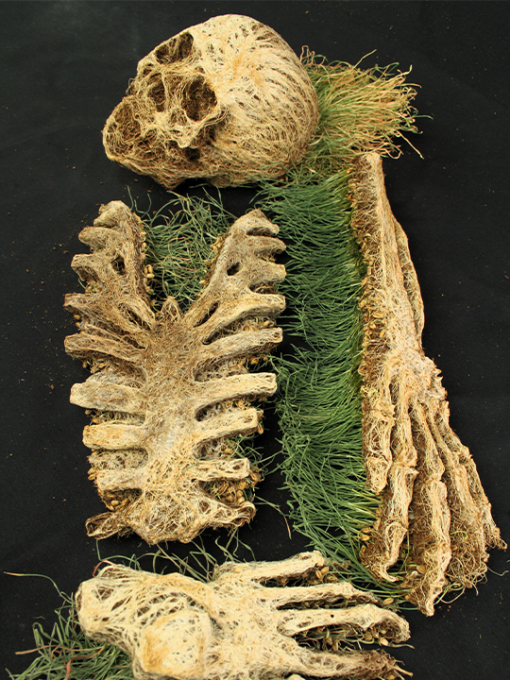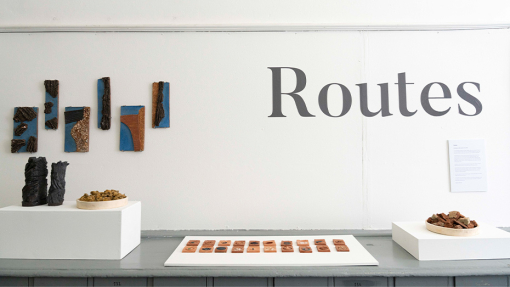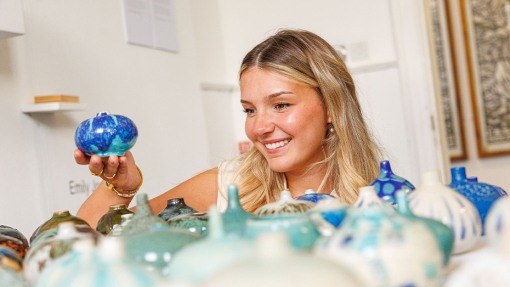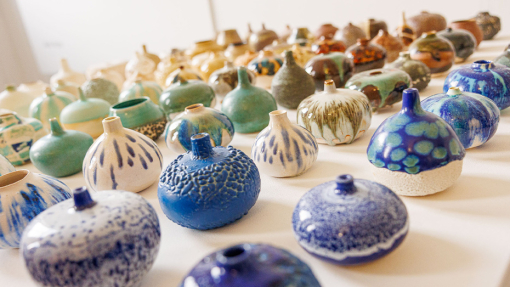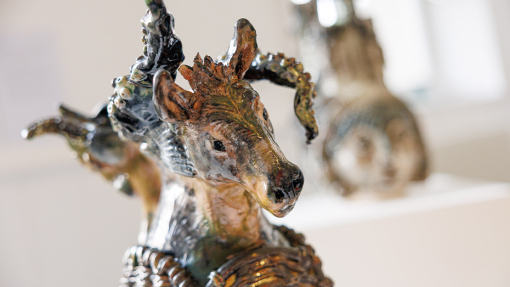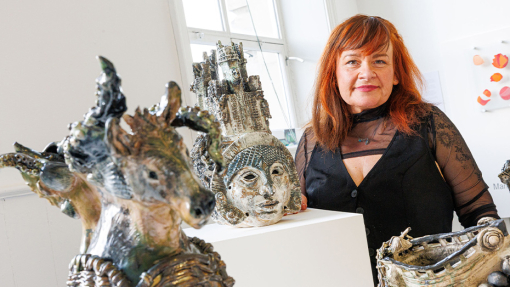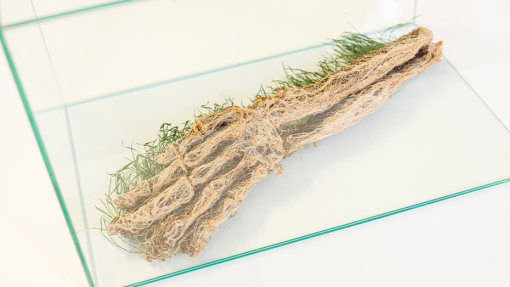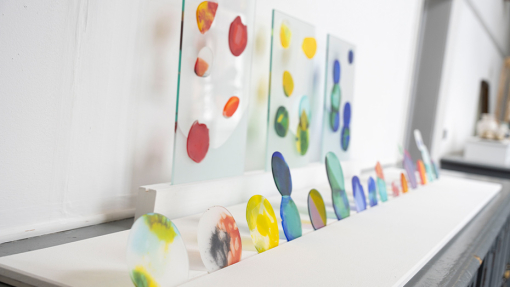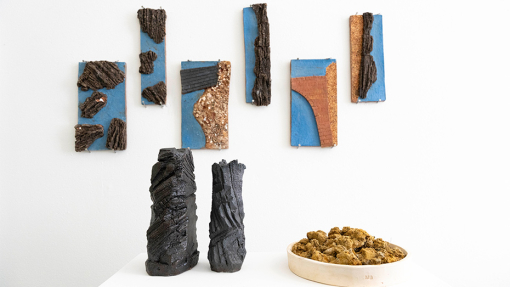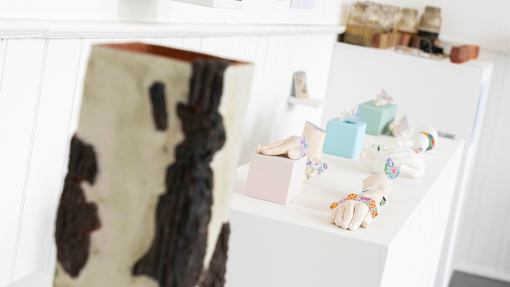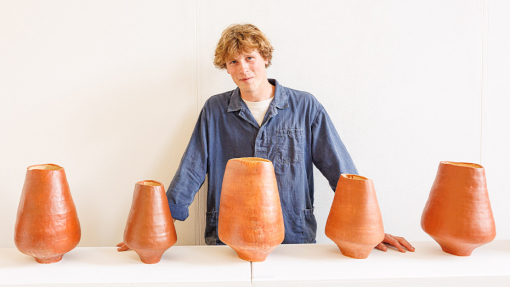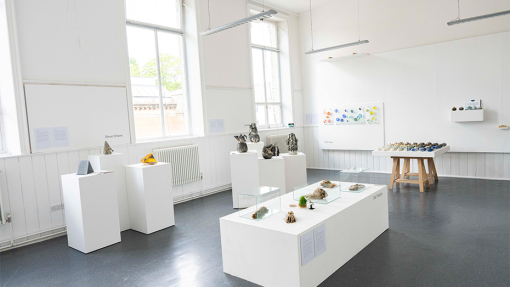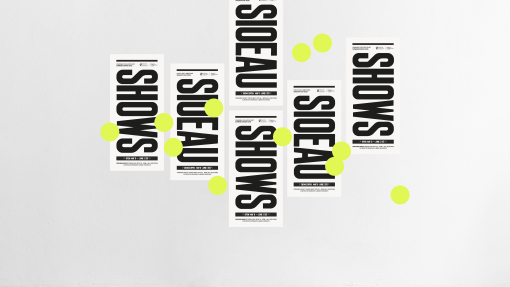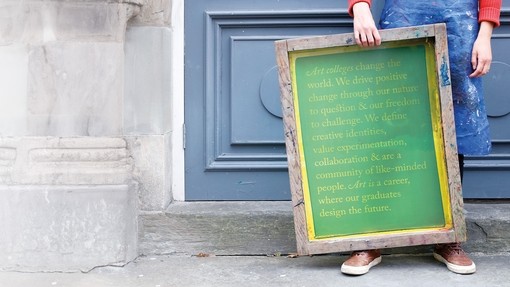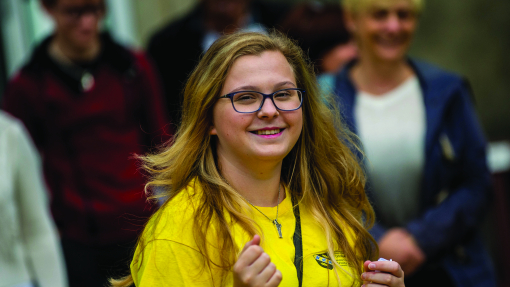Design Crafts Glass, Ceramics and Jewellery
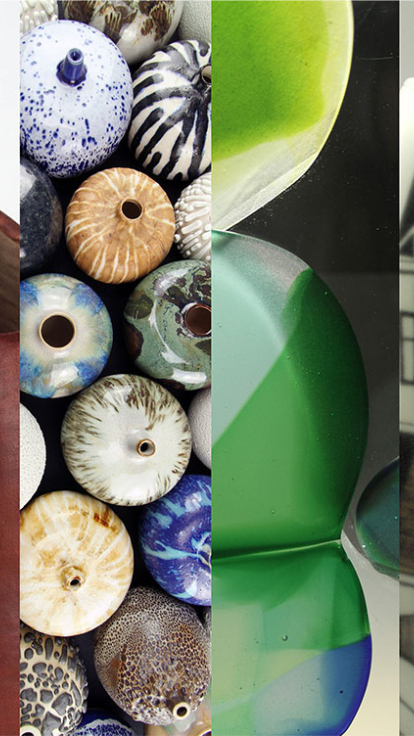
Routes
BA Design Crafts Degree Show 2025
A rich exploration, as always in this year’s Design Crafts show at Swansea College of Art. Artwork ranges from hand-painted and bonded glass inspired by drum and base rhythms to kiln-fused coloured glass bubbles that explore mindfulness and fluidity.
In ceramics, there is a strong theme of nature and the natural environment in this year’s graduating cohort. Traditional processes in ceramics have been used to explore concepts around environment and sustainable practice, experimenting with wild clay from Welsh locations. Experimental glazes and thrown vessels that mimic pattern and multiples in nature. These sit alongside large-scale sculptural pieces that have dark tales to tell.
In addition to this, you will see natural material innovation where anatomy-like forms have been grown from seed to root, commenting on the transience of life.
Design Crafts gives students the opportunity to learn the creative 3D-making skills they need to work professionally with glass, ceramics, and jewellery. Our students discover their creative voice while developing traditional hand-making skills and contemporary digital approaches.
We encourage each individual voice and passion, this is evident again in the diverse range of work at this year’s show.
The academic and technical teams would like to congratulate our graduates of 2025. We wish you the best for your future creative journeys, It has been our pleasure to have worked closely with you.
@designcraftsuwtsd
Our Work
As a ceramic artist with a conservation background, I explore the intersection between objects, history, and the environment. Using wild clay sourced from derelict industrial sites in Wales, my work embraces spontaneity and sustainability, transforming abandoned materials into art imbued with sentimentality and a deep sense of place.
My practice is rooted in the emotional resonance of Hiraeth a longing for connection to landscapes and histories. By reclaiming forgotten materials, I aim to create vessels that embody the essence of the land while fostering a dialogue between past and present. Inspired by nature and heritage, my work invites viewers to experience the profound relationship between memory and material, bridging the tangible and the intangible.
- Website: Earthly-creations
- Linktree: brown_searthly_creations
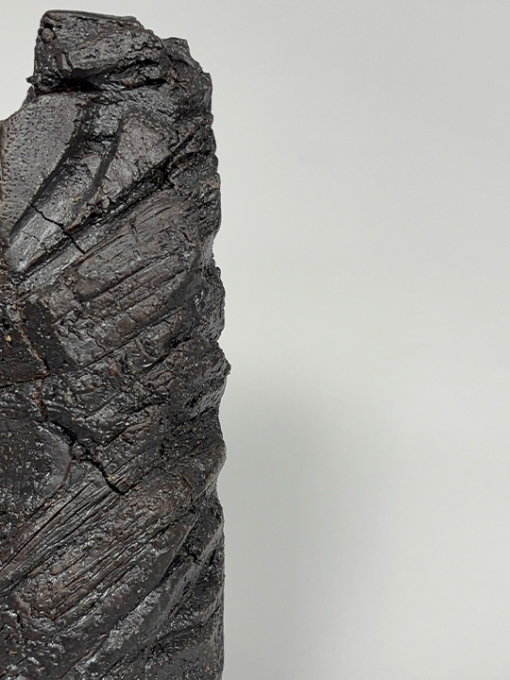
Storytelling is where my work begins and ends. Tales, characters and lore from old Welsh mythology and historical narratives inspire me to create. I seek out the voices of the overlooked and the forgotten, letting their stories guide my drawing and those illustrations inspire my making.
These tales are historical, cultural, mythical. I am drawn to the grotesque, the unexpected and the mysterious.
I use my drawings as a blueprint, developing them into sculptural works that bring imagined ideas into physicality. These are classic yet at the same time unconventional, perhaps disturbing, yet inviting the viewer to look closer inviting them to embark on a journey, through stories hidden within my creations. Historical, social themes emphasising the passing of time and backdrops that reflect industrial, traditional, architectural, or iconic, all mixed surreally.
My sculptures are like portraits of the stories they originate from. They celebrate resilience, unity, strength, and hope. Embracing and finding beauty in what is strange and odd. Weaving themes of death and the sublime, serving not only as a remembrance of forgotten legends but as an exploration of the power of narrative, magic and memory being beautifully different.
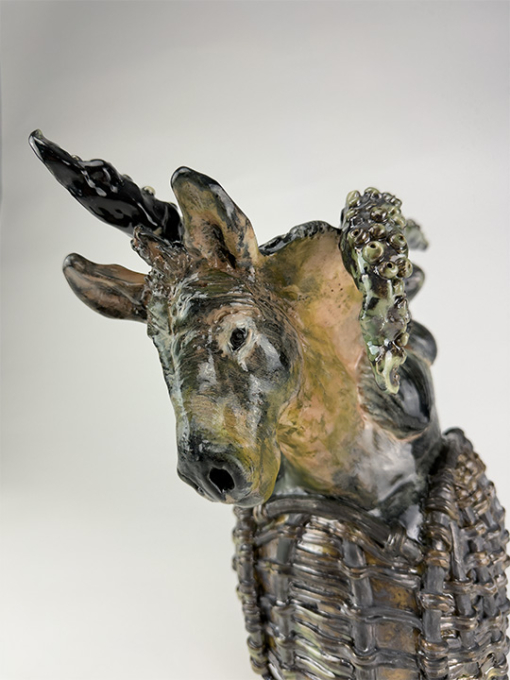
Emily Jones is a ceramic artist whose practice is defined by relentless curiosity and a passion for pushing the boundaries of glaze. Throughout her time at university, she immersed herself in every aspect of ceramics, from the precision of wheel throwing to the alchemy of glaze chemistry.
Her work fuses craft, science, and nature in pursuit of a bold goal: to harness the psychological and physiological benefits of nature through ceramic art.
During her dissertation research on biomorphism, Emily discovered that humans experience measurable health benefits not only from direct contact with nature, but also from exposure to nature-reminiscent patterns, colours, and textures.
With this insight, she set out to capture nature’s essence in glaze.
Her latest series is a study in experimentation, combining glaze chemistry and kiln unpredictability to create organic, evolving surfaces that mimic the textures and hues of the natural world. Each palm-sized vessel is thrown, trimmed, and offered as a canvas for the glazes to flow and transform — an intimate object designed to restore the human connection to nature in a digitally saturated world.
Emily’s work challenges the limits of ceramics, positioning it as both material innovation and a tool for emotional and sensory well-being.
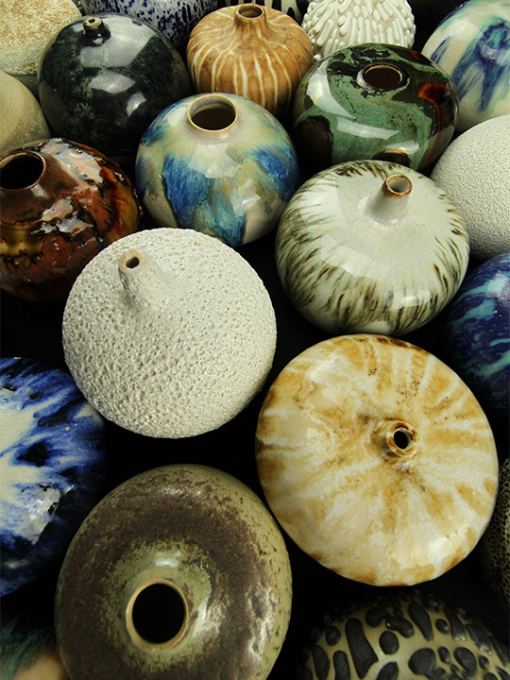
The purpose of this project was to create a physical representation of my experience of hiking around the Pembrokeshire coast path. This journey was completed through June of 2024, and was truly one of the greatest achievements of my life.
Using references that were collected along the way in my diary, each of these eleven pieces have been made as an embodiment of this journey. The size of each piece was dictated by the distance of miles cover in a day, and the colour of each vessel comes from the wild clay that has been collected within that day’s mileage. This project has re-connected me to the land I grew up in, taught me more about it, and let me truly explore the notion of “hiraeth”.
All eleven of these pieces have been coil-built, in a slow methodical way that mimics the walk itself. I was initially inspired by vessels of the early Britons, before distorting and evolving into their wonky bulbous forms. The foraged clay was processed and made into a usable material, before being transformed into the ancient method of sealing ceramic, terra sigillata.
To accompany the main eleven pieces, I have also made a range of thrown vessels, as a reflection of the larger pieces. This smaller form is where the initial shape of the larger pieces came from, and has let me create a set of more functional objects. Lastly, to show the clays true personality, each location has a matching dorodango. This technique captures the raw characteristics of the clay, standing as a stark contrast to the fired pieces.
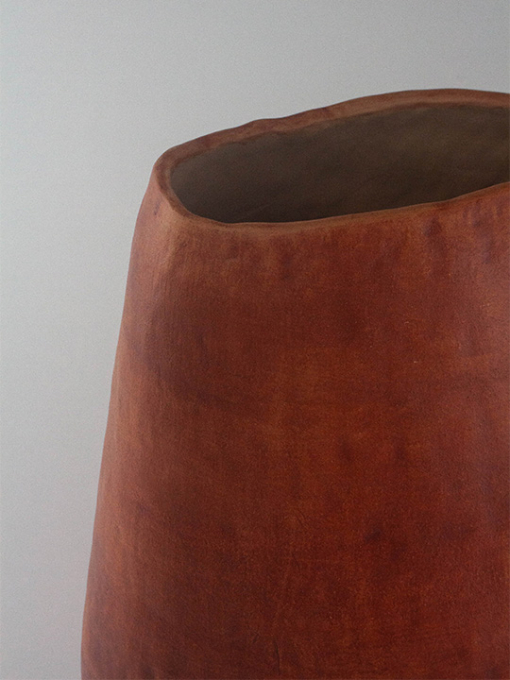
Emotional Echoes in Glass explores the shifting, often unpredictable nature of human emotion, drawing on the principles of neurographic art to create flowing, organic patterns. Avoiding rigid structure, the sandblasted linework captures the complexity of lived experience through soft, undulating forms.
The kiln-pressed glass introduces layered depth and movement, mimicking the fluidity of watercolour. Each piece incorporates a thoughtfully considered palette that responds to emotional resonance, ranging from turbulent and intense to calm and uplifting.
Guided by personal reflection and a deep interest in visualising the internal landscape, this work proposes a dialogue between material and emotion. Through texture, pattern, and colour, the collection invites contemplation on how our feelings move, overlap, and evolve.
- Instagram: @mariejoyglassartist
- Website: mariejoyglassartist
- Email: mariejoyglassartist@gmail.com
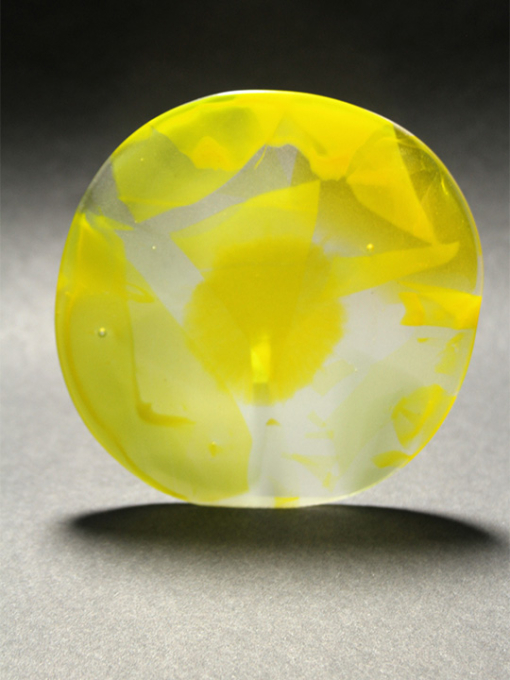
Rhythm within glass is an exploration of the sounds and rhythm of the heavy, solid and powerful drumbeat found within drum and bass music portrayed within glass.
Depicted differently in each individual piece, the power of the drum is meant to come through and hit you, fill you with energy and a sense of life.
All the glass has been painted by hand to the beat of the drum, and the shapes, colours and textures that have materialised are conceived from the music. Black triangular shapes are what I visualise the beat to look like and these are constructed to visually seem to float within the atmosphere around them. The juxtaposition between dark heavy forms and the misty sandblasted atmosphere is presented in each piece.
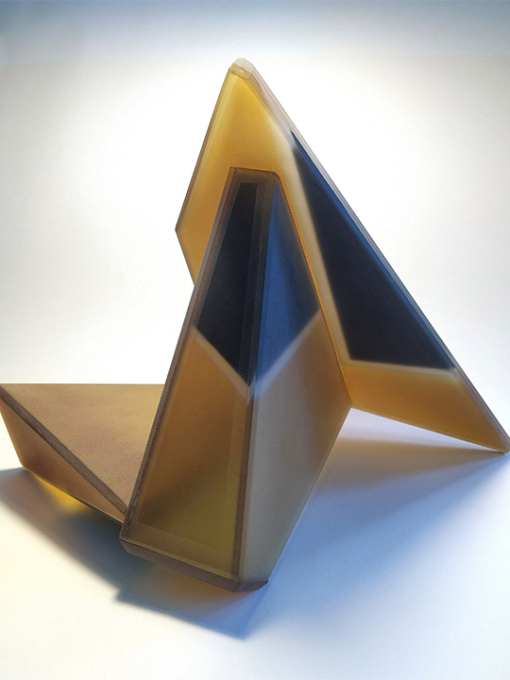
In my most recent collection of artworks, I use plaster hands to examine the connections between decay and vitality, with each piece featuring small, intricate paints that encourage reflection. These hands represent both fragility and strength, and they are purposely worn and aged to convey this. The dilapidated façade symbolises the passage of time, whilst the vivid, colourful interiors indicate a secret inner world of life and creativity waiting to be uncovered.
My love of painting small figurines has a strong influence on my work. I appreciate paying attention to detail and creating smaller stories in small settings. By extending this method to larger, sculptural forms, I can create a dialogue between the delicate and the bold, with vibrant colours. This transition from tiny to larger pieces allows me to experiment with new ways of telling tales and question established notions of scale in art.
The brilliant colours that emerge from rotting surfaces represent strength and beauty in imperfection. Each colour signifies a particular emotion or experience, demonstrating that even when things appear to be shattered, there is still hope for brightness and rejuvenation. I wish to modify people’s perceptions about deterioration, encouraging them to see it as a natural part of life rather than something to be avoided or feared.
Through this collection, I wish to promote the idea of metamorphosis, where decay and colour can coexist together. I believe that art has the power to inspire emotions and provoke thought, and I want to produce pieces that strike a deep chord with viewers.
My art encourages viewers to notice the beauty in both the faded and the brilliant, reminding them that life is full of surprising contrasts. I want my art to be a mirror, inspiring contemplation and inviting discussions about life’s complexities, reminding us that each layer is a narrative waiting to be discovered
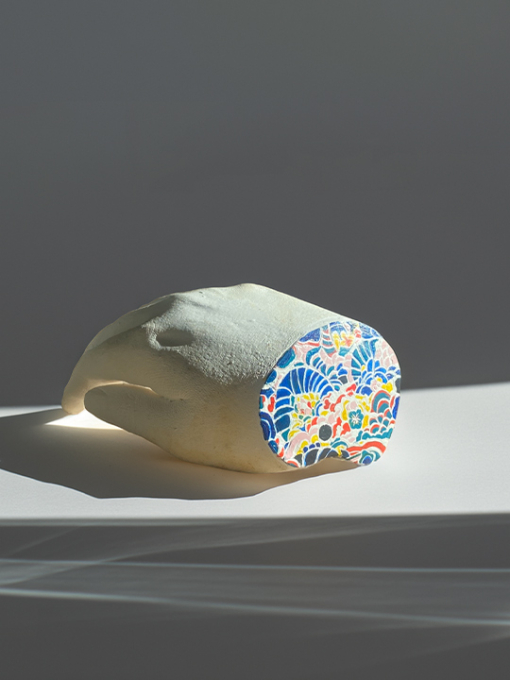
Vitae Vestigia – Traces of Life
Vitae Vestigia is a collection rooted in transformation—of material, memory, and meaning. By guiding the growth of wheatgrass roots within latex moulds cast from human skeletal forms, I explore the tension between life and death, control and unpredictability, presence and absence.
The five pieces in this series take the form of the sternum, spine, foot, forearm and hand, and skull. These skeletal parts are instantly recognisable, yet rich with layered symbolism—movement, identity, protection, and the fragility of the human condition. As the roots grow, they interact with these forms, softening them, reshaping them, allowing nature to reclaim what once was fixed.
This body of work draws on philosophies of dark ecology and the uncanny, as well as the tradition of memento mori, reimagined through an ecological lens. The roots become living collaborators, shaping and softening the contours of the body, revealing the resilience of organic matter and the inevitability of decay.
Working with living materials has required patience, vulnerability, and a willingness to let go. This project has challenged my expectations of control and perfection, teaching me to embrace discomfort and trust the process of change.
Vitae Vestigia is not just a series of objects—it is a conversation between the body and the earth, between decay and regeneration, between what was, and what continues to grow.
